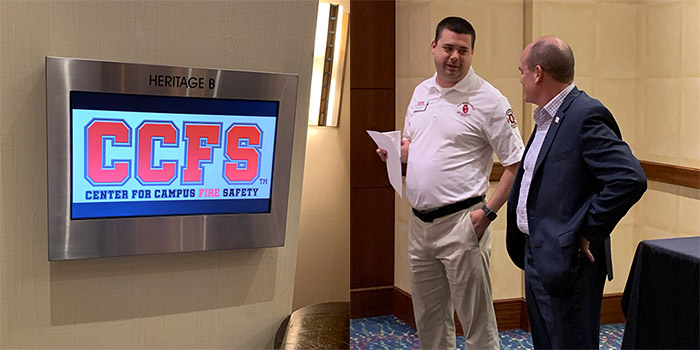2019 Campus Fire Forum Interview: CCFS President Justin Daniels
Posted on November 22, 2019 The Center for Campus Fire Safety (CCFS), a valued member of the Safer Buildings Coalition, last week hosted its annual Campus Fire Forum in Atlanta. The Forum kicked off with a special 3-hour presentation by SBC Executive Director Chief Alan Perdue and followed up with an extensive list of engaging and educational presentations that addressed issues important to fire safety on the nation’s college campuses. In addition to Chief Perdue’s presentation, the Safer Buildings Coalition participated in the Campus Fire Forum as both a sponsor and exhibitor.
We had a chance to catch up with CCFS President and University of Oklahoma Fire Marshall Justin Daniels for a chat about the Campus Fire Forum and how the CCFS works to make campuses safer.
Safer Buildings Coalition: Why are you hosting the Campus Fire Forum every year?
Justin Daniels: The purpose of the event is to gather fire and life safety professionals from colleges and universities from all over the country to discuss new ways we can keep our students, faculty, staff, and visitors to our campuses safe. We also get a unique opportunity to work with our nonprofit and sponsorship partners to educate our members on new technologies and industry best practices. Our conference is famous for the networking opportunities and chance to meet like professionals from all over the United States who do what we do on our campuses every day. It’s great to talk and learn from some of the best in our industry.
Safer Buildings Coalition: What are some of the highlights of this year’s event?
Justin Daniels: The speakers and educational sessions are some of the best we’ve ever had. Our opening session with Chief Alan Perdue was exactly what our members needed to hear and addressed a critical issue I’m not sure a lot of our folks fully understand. Kristin Tucker Tinney’s keynote titled Every Bear Goes Home was amazing, and our breakout sessions were taught by some of the leading experts in fire and life safety. One that really stuck out was the session with Jon Roberts from UL. He did a hands-on session with mock-up sheet rock walls where session attendees got to actually apply firestopping to pipe penetrations and wall-floor gaps. It was incredible and extremely humbling for some of our fire marshals in attendance to struggle with something they inspect every day but maybe haven’t actually done themselves. Safer Buildings Coalition: Are wireless dead zones a real problem at American college campuses? On yours?
Justin Daniels: Absolutely. Dead zones are a real problem anywhere, so I’d be lying if I said our campuses, or my campus in particular, are any different.
Safer Buildings Coalition: How does the existence of such dead zones affect the public and first responders in an emergency situation, such as a fire or active-shooter event?
Justin Daniels: I’ve attended several events this past year as President of CCFS, and the one common theme among all of those events is that communication is the key to quick resolution of any emergency situation. And not just communication within EMS, Fire, or Police but interoperability between the groups. An active shooter situation involves ALL first responders, from the police that stop the threat, to the fire and EMS teams that perform search and rescue. Lack of communication in those types of events can potentially delay entry into the building for police, as an example, or delay fire and EMS from getting to a patient needing medical care. We have buildings on campus that we know are a problem for communication and the key is to develop a long-term plan to how we can address it. This is not unique to any one campus but applies to almost all campuses.
Safer Buildings Coalition: What can be done to eliminate this problem? What are campus fire marshals like you doing to address this issue?
Justin Daniels: The key to addressing or eliminating this problem is education. I say this all the time: We still have a significant number of fire marshals, code officials, and other safety personnel out there that don’t understand in-building communications, how they work, and how to go about fixing the problem. Sometimes it can seem like such a huge task to address, especially with existing buildings, but the stakes are too high to ignore the problem. It’s not going away and educating the decision makers who require the systems to be installed is the only way we can make progress.
Check out all the images from the 2019 CCFS Fire Forum:
Safer Buildings Coalition: How can the Safer Buildings Coalition help achieve this objective?
Justin Daniels: You can help us educate the decision makers. The Center for Campus Fire Safety’s members are the key decision makers and AHJs on their campuses. Helping them understand in-building emergency communications and providing them with the tools they need is the best way we can improve the issue of poor communications for our first responders.
Next year’s Campus Fire Forum takes place at Seton Hall, NJ, November 2-6.
For more information about the Center For Campus Fire Safety, please visit: https://www.campusfiresafety.org
|

